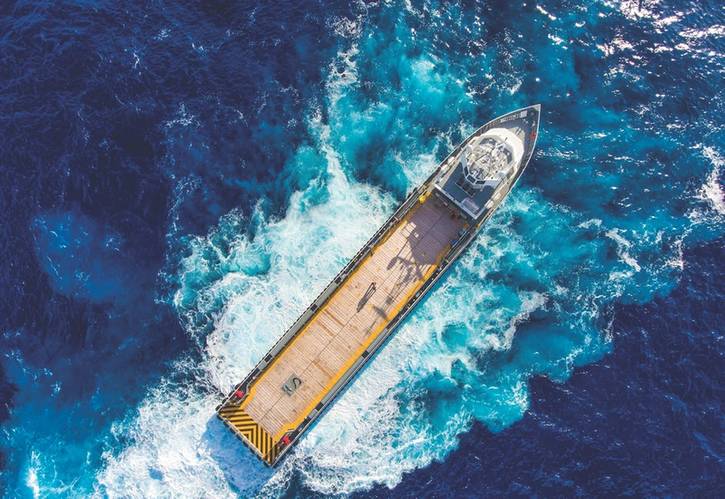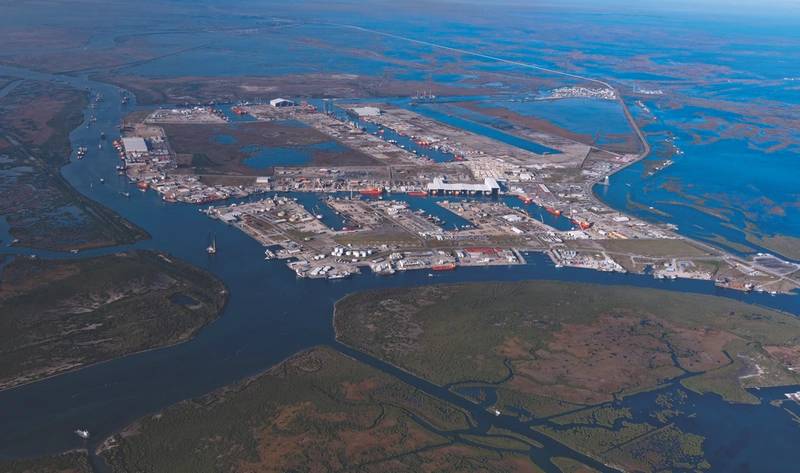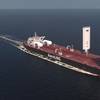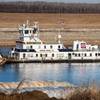Gulf of Mexico vessel operators want to see sustained, higher oil prices.
After a rough two years, supply boat owners and operators in the Gulf of Mexico hope crude oil prices will improve in 2017. That would encourage activity among the offshore drillers that they service and would put unemployed boats back in the water. Vessel owners aren’t necessarily banking on a good year ahead, however.
“Utilization of OSVs and PSVs in the Gulf is below 50 percent now, down from about 70 percent a year ago and 90 percent two years ago,” Peter Laborde, Jr., founder of Laborde Marine, estimated in early October. “Of course, we don’t know where crude oil prices will go from here.” He fears the region’s demand for supply vessels many not get any better for another two years or so. With a fleet of 22 crew boats and supply boats, New Orleans-based Laborde Marine has an operations office in Morgan City, La. The firm’s international unit provides offshore supply vessels and line handlers in Brazil’s Rio de Janeiro area.
In early October, buoyed however briefly by hopes that an OPEC production cap would provide price supports, West Texas Intermediate crude reached $51.50 a barrel on the New York Mercantile Exchange, up from $41.25 in mid-August. As MarineNews went to press, stability in the oil markets was anything but certain, however.
GoM Output Rises, but Rig Numbers, Spending Dips
Capital spending by big oil producers is lower in the Gulf of Mexico this year, as it is worldwide, Loren Scott, Louisiana State University emeritus economics professor, said in October. “The count in the Gulf fell to 14 offshore rigs earlier this year from 56 in 2014,” he said. “Drill ships are tied up or not working. Hornbeck, Chouest and Tidewater each have lots of offshore supply vessels that are without work.”
Gulf oil production is up this year, however, and will continue to rise in 2017 because of deepwater projects that began eight to ten years ago, Scott said. The U.S. Energy Information Administration sees Gulf oil output averaging 1.63 million barrels per day this year and 1.79 million bpd in 2017. Output should reach a record 1.91 million bpd in late 2017, exceeding a peak in 2009, the year before the BP spill. In addition to the start-up of fields that were developed when crude was around $100 a barrel, Gulf oil output has grown as technologies are adopted for developing satellite wells in or near producing fields.
In February, the EIA said: “GOM production is less sensitive to short-term price movements than onshore production in the lower 48 states is. Decreasing profit margins and reduced expectations for a quick oil-price recovery, however, have prompted many GOM operators to pull back on future deepwater exploration spending, to scrap and stack older rigs, and to restructure or delay drilling rig contracts.” That said; Reuters was reporting in mid-September that the market adding rigs in 11 of the previous 12 weeks, according to market barometer Baker Hughes.
A decline in working rigs in the Gulf has taken a toll on employment, Scott said. The Lafayette, La. area should lose 9,000 jobs this year and possibly 5,000 next year, while Houma, La. could be down 5,400 jobs this year and 4,000 in 2017. Louisiana as a whole should lose over 17,000 jobs this year. Shipyards along the Gulf have shed workers. Edison Chouest Offshore in Cut Off, LA has laid off more than a thousand people from its yards, and has 100 boats tied up now. Chouest didn’t respond to requests for comment in October.
Separately, Houston-based, oilfield-service companies Schlumberger and Halliburton have made huge layoffs in the last two years. “All kinds of jobs have been lost along the Gulf, and that’s had a multiplier effect on the retail, wholesale and other sectors of the region’s economy,” Scott said.
Vessels Stacked Along the Coast
Offshore vessel builders and operators, including Edison Chouest Offshore, Bollinger Shipyards, Hornbeck Offshore Services, SEACOR Marine and Gulfmark Offshore, have had to retrench.
In early October, an officer at Hornbeck in Covington, La. said the company couldn’t comment on conditions in the Gulf because its Nov. 2 quarterly earnings were approaching. Hornbeck serves deepwater exploration and production with marine transportation and subsea installations. At midyear, the company owned 62 new-generation OSVs – including two new-builds that were delivered early in the year – and 6 MPSVs.
Because of the soft offshore market, Hornbeck was forced to make company-wide cuts in its shore-based and vessel staffs, along with pay reductions, the company said in its August earnings report. Hornbeck from October 2014 to mid-2016 stacked 48 new-generation OSVs, including eight 300-class OSVs. In this year’s first half, Hornbeck had an average of 37.8 vessels stacked, versus 13.5 in the same 2015 period. And on June 30, Hornbeck had 44 OSVs that weren’t in use.
Separately, and in its August 10 earnings report, New Orleans-based Tidewater said that because of the reduced demand for OSVs and an increased supply of them, the company had seen a significant decline in vessel utilization, average day rates received and vessel revenue. On June 30, Tidewater had 181 active, owned or chartered OSVs and 87 stacked boats. That compared with 245 active, owned or chartered vessels and 28 stacked boats just one year prior.
Florida-based SEACOR Holdings Inc., the parent of SEACOR Marine in Houma, La., had 25 of its 33 owned and leased vessels cold-stacked in the Gulf at mid-year, according to the company’s Aug. 1 quarterly earnings. Of the 25 vessels stacked, 13 were liftboats. SEACOR Marine’s vessels serve offshore oil-and-gas exploration and production.
Lag Between Rising Oil Prices and OSV Demand
“The OSV market appears to be finding a bottom and is staying flat for now,” Blake Miquez, president and CEO of SeaTran Marine, LLC in New Iberia, La., said in early October. With a fleet of 21 vessels, SeaTran is one of the top providers of crew and fast supply boats in the Gulf.
“We haven’t seen oil prices recover enough for supply boat activity to increase at this time,” Miguez said. “The upcoming presidential election adds to overall uncertainty. A lag, or delay in time, exists between improvement in oil prices and demand for offshore services and vessels, and that’s mainly because of a need by companies to plan and budget.”
Miguez, who is also the Louisiana House representative for District 49 and an executive vice president at Miguez Fuel in New Iberia, serves on the board of the Offshore Marine Service Association. He has heard estimates that demand for OSV-type vessels in the Gulf is only a third of what it was before oil prices sank in late 2014. “My own guess is that Gulf utilization is between 35 and 40 percent now,” he said. Before crude prices dropped, SeaTran in 2013 was expanding. The company added two 205’ class DP2 FIFI FSVs to its fleet, with one in November 2014 and another in March 2015.
Port Fourchon’s Discount to Tenants Could Extend into 2017
In October, Chett Chiasson, executive director of the Greater Lafourche Port Commission, said utilization of OSV-type vessels in the Louisiana Gulf was very low. Since March 2015, Port Fourchon has given tenants a 20-percent reduction on basic land rentals. “This discount is approved until December, but given current conditions, we anticipate extending it into 2017,” Chiasson said. About 80 firms, including oil and gas companies, hold 140 leases at the port.
The 1,200-acre port services about 90 percent of all deepwater activity in the U.S. Gulf. It’s considered a key one-stop service spot by the oil industry. From there, vessels carry water, liquid mud, pipes and other equipment, food and personnel to offshore rigs and platforms. “Though oil prices have improved, we need to see higher prices for a sustained period of time, along with more rig activity, to truly have an impact on port activity,” Chiasson said.
Layoffs Grew from late 2015 to Last Spring
How bad did things get on the coast? “The oil price decline in late 2014 accelerated, and by May and June of last year the industry began to experience layoffs,” Houston-based Mitzi Alario, vice president of business development and marketing at SeaTran Marine, said. “From October 2015 to April 2016, layoffs had become massive. Many companies are in their third round of layoffs now. Several have filed for bankruptcy. We’ve witnessed a gruesome, domino effect.”
“Many companies went into a cash-conservation mode early on, fearing the offshore industry’s decline could last a long time, as it did from 1981 to 1991,” Alario said. “This downturn isn’t expected to be as lengthy as that one, but companies are playing it safe. Construction of vessels, except for new builds which had already started, came to a near-halt this year.”
“With few plans to drill and a reduction in offshore lease sales, there’s no need for rigs, little need for boats and helicopters to transport people, and little need for drilling fluids, tank cleaning, cranes, parts, supplies, truck fleets and client entertainment,” she said.
Alario said all the U.S. coastal operators that she knows have stacked vessels – 10, 20 or 100 – and have laid off workers. “One FSV stacked usually results in at least eight people being laid off,” she said. “In the OSV sector, a boat stacked means at least 12 crew will be terminated. Less boats working means fewer people are needed in operations, logistics, sales and administration. Most of those who remain have had to take pay cuts. And remaining crew members are working reduced schedules now, partly to keep people employed.”
Oil Price Stability is Needed
Vessel owners and operators who had invested heavily in training their staffs have reluctantly released workers, Alario said. A number of these former employees have found new jobs by now, in some cases away from the Gulf. When the offshore market rebounds, companies will have to begin the training process all over again, she said.
“We’re waiting for higher prices per barrel, but the industry also wants to see oil-price stability,” Alario said. “That would give companies confidence to invest in exploration and drilling programs and would encourage hiring and training by offshore vessel operators.” Only time will tell.
(As published in the November 2016 edition of
Marine News)






















